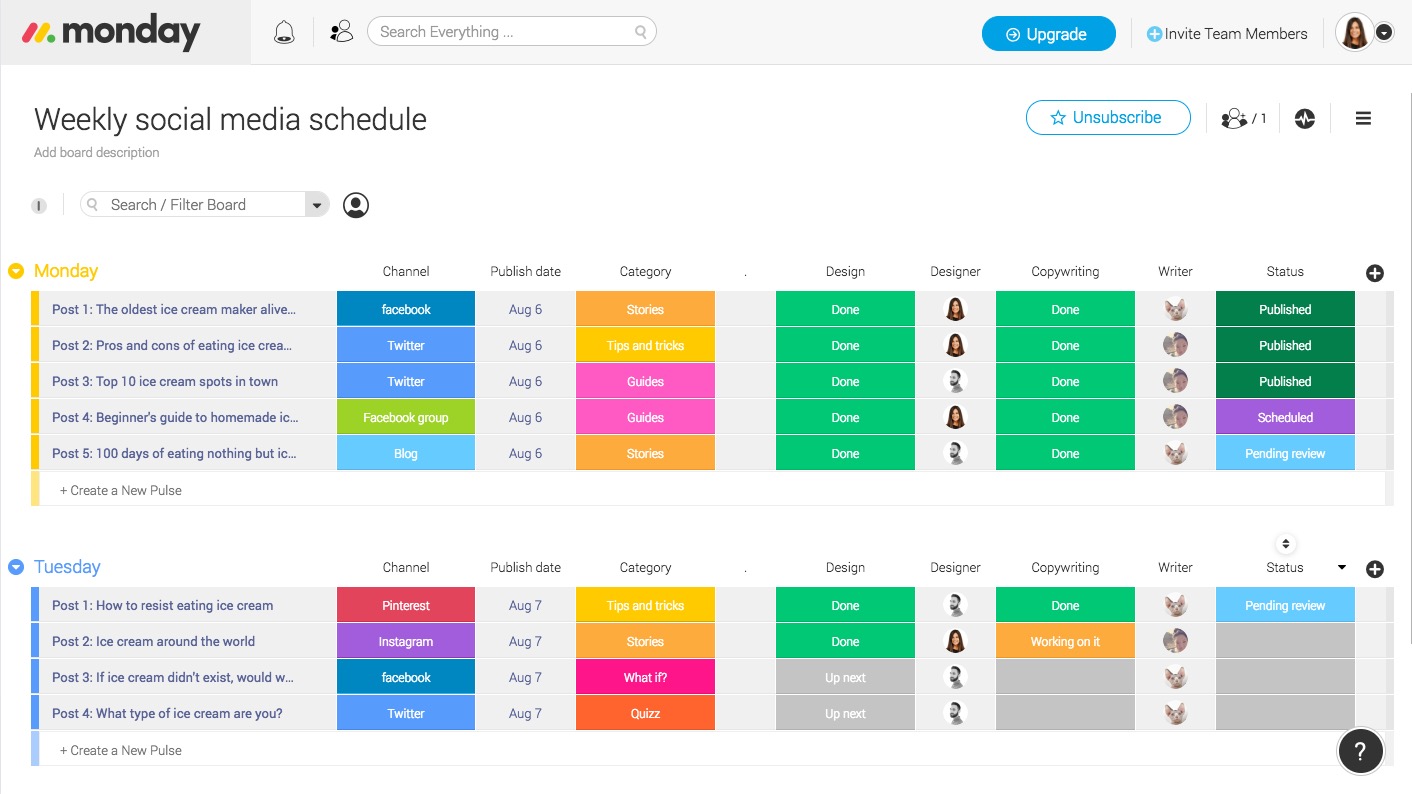If I had to describe what we’re trying to achieve with monday.com in one word, it would be “transparency.”
A lot of people are talking about business transparency these days, and many managers know that it’s something they should strive towards. But what is transparency, really?
Transparency means making all information—numbers, roadmaps, plans, challenges, and concerns—readily accessible to everyone on your team.
It’s about building a strong company culture where the money in the bank, all performance metrics, and what everyone on your team is working on is visible and clear to everyone.
The reason it’s so important can be summed up by what Avishai Abrahami, the CEO of Wix, once said:
“When you hide information from your team, you limit their intelligence to that of your own, crippling the smart people you hired.”
That statement is the driving philosophy behind monday.com. When you create transparency, you can harness the full intelligence of your team, move faster and smarter, and achieve so much more together.
Some people might associate the word transparency with an idealistic, new agey, touchy-feely approach to management, but I advocate it because from a business perspective, it gets the best results.
So how do you build transparency in your team? I’d like to share what we do both here at monday.com and the best practices we’ve learned from thousands of our customers.
KPI transparency
Everything here at monday.com starts and ends with data—we meticulously track and measure everything we do. We couldn’t find a business intelligence tool on that market that we liked, so we built our own internal tool that we fondly call BigBrain.
BigBrain has everything in it: every dollar we’ve spent, every dollar we’ve received, how our customers are engaging with our product, how quick our support response time is, and more.
Everyone at monday.com has access to BigBrain and is encouraged to monitor our performance. We don’t hide anything. In fact, we’ve made it impossible to miss—we have huge dashboards all over our office that are driven by BigBrain, giving a real-time picture of exactly where our business stands.
As a result of this investment, BigBrain is an integral part of everyone’s work here at monday.com. (We’ll follow up soon with an in-depth blog post showing you what BigBrain is all about.)

Roadmap and workload transparency
It’s also essential to create transparency in your day-to-day work: who’s working on what? Where do things stand? What are your goals? What’s the highest priority? To share the work we do and centralize all communication, we obviously use monday.com.
As a result, we all understand how our individual tasks contribute towards the bigger picture and what we’re trying to achieve together as a team. We communicate clearly, we don’t have many meetings, and we pretty much never use email.
One of the best ways to gauge transparency is when someone asks a question about where things stand, the people here respond, “It’s in monday.com.” They don’t have to specify further; it’s obvious where it is—accessible to everyone. In contrast, email communication is not inherently transparent. The response “I’ll send it to you” necessarily excludes everyone else, and even unintentionally, leaves members of your team in the dark.
 monday.com board example – transparent and accessible to all employees
monday.com board example – transparent and accessible to all employees
Operational and HR transparency
In the weekly team meetings that we do have, we are transparent with everyone who works at monday.com about all company news. We provide updates on our latest round of funding, hiring, and our plans for the future.
Our meetings are generally an open forum where we welcome questions and participation from everyone who works here. There isn’t anything that is off-limits. This is important because we want everyone on the team to feel invested and involved, and we truly believe that everyone’s opinion matters.
Benefits: Why you should be transparent
You have total freedom: When you share everything, you don’t have to remember who knows what, watch what you say in front of whom, and fear you might let something slip. You are free.
You eliminate office politics: Information is power in traditional office environments. When some people know things and others don’t, it becomes a hotbed for organizational politics to thrive. There are groups of people “in the know” and a constant chase of people not in the loop to try to get in the loop.
People spend a lot of energy on office politics and it’s a tremendous waste of time and effort—it doesn’t help the organization move forward. When everything is out in the open, there is no hierarchy of those who know and those who don’t.
Motivation goes off the charts: When information is available to everyone, people see the bigger picture and understand how their actions make an impact. People see that their work matters. At the end of the day, that’s what makes people happy at work—to feel that they’re making a difference.
Here with our team, we make all information accessible to everyone, and then encourage the smart people we hire to come forward with their own ideas and initiatives. This is a win-win because people get to work on what they love, and our whole company benefits from new ideas and directions we had never before considered.
You reduce management energy: When you limit information, managers still have to mete out the exact information employees need to get their work done. You’re then the only one who understands if the work they did had an impact or not. The burden is always on you to relay the information and adjust the course for everyone on the team. That’s exhausting.
Instead, when all information is available and clear, everyone can see if their work is successful or not. They’re empowered to make improvements on their own. Your job as a manager is simply to make sure that they have the information and understand it properly to make these improvements. That’s much easier and way more rewarding for everyone.
You share responsibility: Much like the previous point, when you limit information, the burden of responsibility is solely in your hands. You can’t rely on your team, and you’re essentially alone.
When you share information, you share responsibility with your team. That makes you feel less alone when you strike out as group and is more fun when you succeed—you can celebrate as a team.
You get better results: When everyone’s eye is on the same ball, it rallies everyone to find problems and fix them faster together. No eyes = no ball. This is the overarching reason I stand by transparency—I can rely on the smart people around me to achieve incredible things, and the results are so much better than if I was working alone.
Difficulties: Why transparency can be hard
You have to overcome fear and let go: It’s always an easier decision to not share information. It’s really hard to let go. People rationalize not sharing business data for fear of it leaking out. They rationalize not sharing roadmap data for fear of not being able to change it. They rationalize not sharing goals for fear of not reaching them.
In my experience, being afraid never helped me—not even once. When we added the dashboard in our lounge with all our business data, people asked me if I was afraid to be exposed like that. When we had articles written on our dashboard and photos of it were shared around the web, I got emails asking if I was scared for competitors to see it.
The truth is, sharing this information helped us a lot. It made the team proud and it attracted job candidates and investors. Sharing information says a lot about your confidence, and it attracts people.
You have to answer questions: As I mentioned previously, when you share information, you’ll get lots of questions. Why didn’t we reach our goal? Why is that important metric going down? You’ll have to look for answers, which can be uncomfortable. People often like to avoid this situation.
Again, running away from what’s uncomfortable usually doesn’t make you successful. At monday.com, we like answering questions. Since we’re not able to hide from the bad stuff, we’re forced to deal with it. Naturally, that helps us improve and achieve more.
You have to justify decisions: Sharing all information also means that when you make mistakes, it’s visible for everyone to see. Again, I understand why that’s uncomfortable for people.
But the thing is, you can’t succeed without making a lot of mistakes. There’s no sense in hiding from them, since they’re the gold that’s paving your path to improvement.
If you work in an environment where you’re penalized for mistakes, transparency is the best way to change that. Everything is out in the open and you can openly discuss the decisions you plan to make. You can then later share responsibility for the good as well as for the bad, which disarms finger-pointing.
Practicing transparency isn’t easy. It requires coming to terms with office politics, letting go of your fears, and stepping outside of your comfort zone. There’s a price to pay for transparency, but it’s minor in comparison to what you pay for not practicing it.
Discover why monday.com is a different team management tool and how it can help you leading a culture of transparency.

